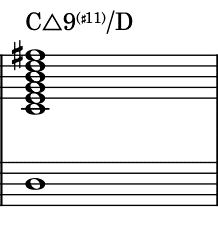Understanding Chord Symbols
Jazz chord symbols can be confusing for learners, but fortunately they follow a pattern, albeit a messy one. Still, it’s what we’ve got, so let’s get cozy with it.
CHORD SYMBOL ANATOMY
Chord symbols are made of up to 5 parts.
- Part 1: the basic triad
To this, you can add…
- Part 2: a 6th or 7th
- Part 3: natural extensions including 9, 11, and 13.
- Part 4: altered notes including b9, #9, #11, b5, #5, b6, b13.
- Part 5: alternate bass notes written under a slash.

Part 1: C = a C major triad = C E G
Part 2: ∆ = major 7 = B
Part 3: 9 = the natural 9th = D
Part 4: #11 = the 11 raised a ½ step =F#
Part 5: /D = put a D in the bass

This example is just one of many possibilities, but it contains many of the things you might run into. Notice anything strange? The ∆ for instance? Its indicating a major 7, but we don’t actually see the 7 mentioned here. There are lots of quirks like this which you’ll just have to memorize.
In the following sections, we’ll get more detailed with each part of the symbol and bring your attention to the patterns and oddities.

